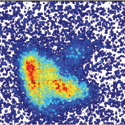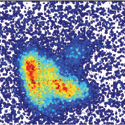An ultracold plasma shows its unstable side
Although plasmas are usually associated with high temperatures, in 1999 a group of researchers at the National Institute of Standards and Technology in Maryland successfully created an ultracold plasma by cooling xenon atoms in a magneto-optical trap and then photoionizing them just above threshold [1]. The resulting ultracold plasma had electron and ion temperatures of only 100 mK and , respectively.
Due to their nonlinear and collective nature, plasmas typically exhibit a large variety of instabilities, as anyone working in the field of magnetic-confinement fusion is fully aware. Because of their extremely low temperature, ultracold plasmas are expected to behave significantly differently from “hot” plasmas [2], but a paper appearing in Physical Review Letters presents the first evidence that ultracold plasmas also exhibit instabilities.
In their experiment, Steven Rolston (one of the authors of [1]), Xian Li Zhang, and Robert Fletcher, all at the University of Maryland, form an ultracold plasma from xenon atoms that then expands more or less uniformly as the hotter electrons leak out of the potential well caused by the ions. This uniform-expansion picture changes when they apply a small transverse magnetic field. In this case, the authors observe large, periodic pulsed emissions of electrons. Although the exact mechanism causing these pulsed emissions is unknown, the group believes they are the signature of an instability caused by the electrons drifting relative to the ions across the applied magnetic field. Similar electron drift instabilities have previously been seen in the hot plasmas in Hall thrusters, which are plasma-based ion-propulsion systems for spacecraft. – Jerome Malenfant
[1] T. C. Killian, S. Kulin, S. D. Bergeson, L. A. Orozco, C. Orzel, and S. L. Rolston, Phys. Rev. Lett. 83, 4776 (1999).
[2] Steven Rolston, Physics 1, 2 (2008).





